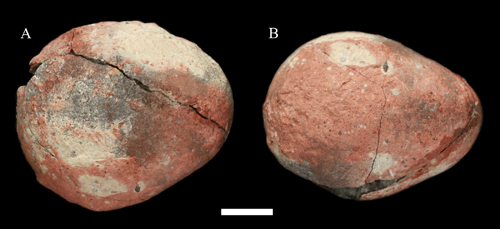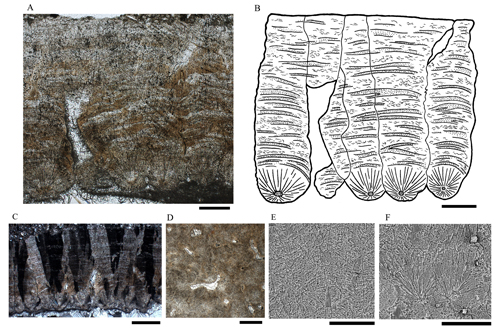| Location: Home > Research > Research Progress |
| New Dinosaur Egg with Avian Egg Shape Discovered from the Upper Cretaceous of Zhejiang Province, China |
|
Numerous dinosaur eggs and a clutch of turtle eggs have been recovered from the Tiantai Basin in Zhejiang Province of China. Paleontologists from Institute of Vertebrate Paleontology and Paleoanthropology of the Chinese Academy of Sciences(IVPP), and Zhejiang Museum of Natural History described a new egg from the the Upper Cretaceous Chichengshan Formation of Tiantai Basin. The new specimen is a small, asymmetrical ovoid egg with avian egg shape, but it has a typical dinosaur eggshell microstructure. A study published online in Historical Biology increases the diversity of the Tiantai dinosaur eggs oofauna and provides new materials to study the eggshell formation and evolution of the dinosaur eggs in the Cretaceous. The new specimen was collected from the Upper Cretaceous lacustrine deposit of Chichengshan Formation of the Tiantai Basin at Jinguo, Tiantai County, Zhejiang Province, China. The egg surface is smooth; a thick layer of calcite crystal is formed beneath the inner surface of the eggshell. The egg is slightly oblate, with dimensions of 45.5mm x 40.4mm x 34.4 mm, and an average shell thickness of 1.12 mm. “Although the new specimen shows the typical avian egg shape in being ovoid with asymmetrical poles, and is comparable in size to other known Cretaceous avian egg fossils, the eggshell microstructure is much different. All known Cretaceous avian eggs have three crystallographic layers similar to those of most living birds today”, said study coauthor Dr. JIN Xingsheng, Zhejiang Museum of Natural History. Compared with egg fossils from nearby localities in the Tiantai Basin and other localities in China, the new specimen shows the typical eggshell microstructure features seen in Stalicoolithidae, Mosaicoolithus zhangtoucaoensis, and Paraspheroolithus. However, the new egg differs from the aforementioned ootaxa by its small size and asymmetrical shape, revealing new morphological variation among eggs with microstructure similar to that of Paraspheroolithus, Mosaicoolithus and Stalicoolithidae. Researchers named the new specimen a new oogenus and oospecies of fossil egg, Parvoblongoolithus jinguoensis (oofamily indet.), thus increasing the diversity of the Tiantai Basin oofauna. Although no fossil skeletons have been found associated with Parvoblongoolithus jinguoensis, eggshell microstructure makes it very unlikely that is belongs to an avian. Researchers suggest the egg belongs to a small non-avian dinosaur closely related to the parent dinosaurs of the Stalicoolithidae, Paraspheroolithus and Mosaicoolithus. This indicates that some avian-like egg features (e.g. asymmetry and small size) may have a wider distribution than previously inferred. "Since all known fossil eggs with similar eggshell microstructure are much bigger than Parvoblongoolithus, and it is well known that domestic fowls, pigeons and some wild birds lay dwarf eggs occasionally, we cannot exclude the possibility that this new specimen represents a dwarf egg. Therefore, it is crucial to discover additional specimens with this type of eggshell microstructure. Unfortunately, no other eggs were found near this new specimen, and thus the description of this specimen as a new oogenus and oospecies is considered preliminary”, said lead author Dr. ZHANG Shukang of the IVPP. This work was supported by the National Basic Research Program of China (973 Program), and the National Natural Science Foundation of China.  Fig.1 Photograph of Parvoblongoolithus jinguoensis (ZMNH M8920), in lateral view from different angles (A,B), showing the slightly oblate shape, scale bar = 10 mm. (Image by ZHANG Shukang)  Fig.2 Eggshell microstructure of Parvoblongoolithus jinguoensis (ZMNH M8920), A, B, E, F, scale bar = 0.2 mm; C, D, scale bar = 0.4 mm. (Image by ZHANG Shukang) |